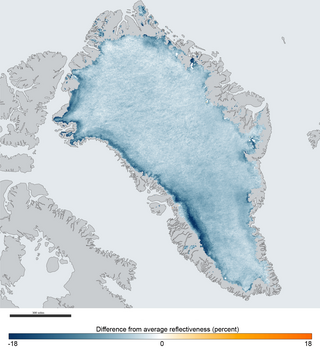
Albedo is the fraction of sunlight that is diffusely reflected by a body. It is measured on a scale from 0 to 1.

Photosynthesis is a biological process used by many cellular organisms to convert light energy into chemical energy, which is stored in organic compounds that can later be metabolized through cellular respiration to fuel the organism's activities. The term usually refers to oxygenic photosynthesis, where oxygen is produced as a byproduct and some of the chemical energy produced is stored in carbohydrate molecules such as sugars, starch, glycogen and cellulose, which are synthesized from endergonic reaction of carbon dioxide with water. Most plants, algae and cyanobacteria perform photosynthesis; such organisms are called photoautotrophs. Photosynthesis is largely responsible for producing and maintaining the oxygen content of the Earth's atmosphere, and supplies most of the biological energy necessary for complex life on Earth.

The reflectance of the surface of a material is its effectiveness in reflecting radiant energy. It is the fraction of incident electromagnetic power that is reflected at the boundary. Reflectance is a component of the response of the electronic structure of the material to the electromagnetic field of light, and is in general a function of the frequency, or wavelength, of the light, its polarization, and the angle of incidence. The dependence of reflectance on the wavelength is called a reflectance spectrum or spectral reflectance curve.

Thermal radiation is electromagnetic radiation generated by the thermal motion of particles in matter. Thermal radiation is generated when heat from the movement of charges in the material is converted to electromagnetic radiation. All matter with a temperature greater than absolute zero emits thermal radiation. At room temperature, most of the emission is in the infrared (IR) spectrum. Particle motion results in charge-acceleration or dipole oscillation which produces electromagnetic radiation.
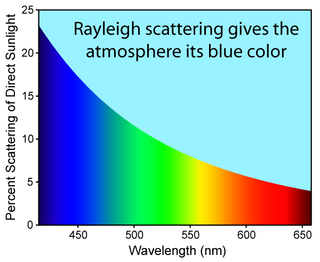
Diffuse sky radiation is solar radiation reaching the Earth's surface after having been scattered from the direct solar beam by molecules or particulates in the atmosphere. It is also called sky radiation, the determinative process for changing the colors of the sky. Approximately 23% of direct incident radiation of total sunlight is removed from the direct solar beam by scattering into the atmosphere; of this amount about two-thirds ultimately reaches the earth as photon diffused skylight radiation.
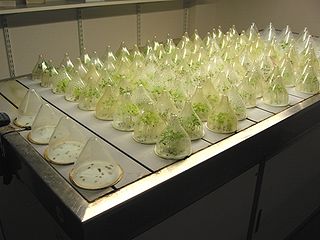
Plant physiology is a subdiscipline of botany concerned with the functioning, or physiology, of plants. Closely related fields include plant morphology, plant ecology, phytochemistry, cell biology, genetics, biophysics and molecular biology.

Black-body radiation is the thermal electromagnetic radiation within, or surrounding, a body in thermodynamic equilibrium with its environment, emitted by a black body. It has a specific, continuous spectrum of wavelengths, inversely related to intensity, that depend only on the body's temperature, which is assumed, for the sake of calculations and theory, to be uniform and constant.

In infrared photography, the photographic film or image sensor used is sensitive to infrared light. The part of the spectrum used is referred to as near-infrared to distinguish it from far-infrared, which is the domain of thermal imaging. Wavelengths used for photography range from about 700 nm to about 900 nm. Film is usually sensitive to visible light too, so an infrared-passing filter is used; this lets infrared (IR) light pass through to the camera, but blocks all or most of the visible light spectrum.
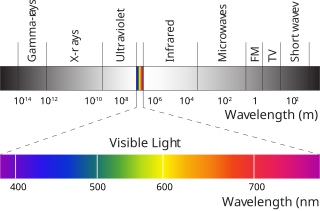
Photosynthetically active radiation (PAR) designates the spectral range of solar radiation from 400 to 700 nanometers that photosynthetic organisms are able to use in the process of photosynthesis. This spectral region corresponds more or less with the range of light visible to the human eye. Photons at shorter wavelengths tend to be so energetic that they can be damaging to cells and tissues, but are mostly filtered out by the ozone layer in the stratosphere. Photons at longer wavelengths do not carry enough energy to allow photosynthesis to take place.
Accessory pigments are light-absorbing compounds, found in photosynthetic organisms, that work in conjunction with chlorophyll a. They include other forms of this pigment, such as chlorophyll b in green algal and vascular ("higher") plant antennae, while other algae may contain chlorophyll c or d. In addition, there are many non-chlorophyll accessory pigments, such as carotenoids or phycobiliproteins, which also absorb light and transfer that light energy to photosystem chlorophyll. Some of these accessory pigments, in particular the carotenoids, also serve to absorb and dissipate excess light energy, or work as antioxidants. The large, physically associated group of chlorophylls and other accessory pigments is sometimes referred to as a pigment bed.

Red edge refers to the region of rapid change in reflectance of vegetation in the near infrared range of the electromagnetic spectrum. Chlorophyll contained in vegetation absorbs most of the light in the visible part of the spectrum but becomes almost transparent at wavelengths greater than 700 nm. The cellular structure of the vegetation then causes this infrared light to be reflected because each cell acts something like an elementary corner reflector. The change can be from 5% to 50% reflectance going from 680 nm to 730 nm. This is an advantage to plants in avoiding overheating during photosynthesis. For a more detailed explanation and a graph of the photosynthetically active radiation (PAR) spectral region, see Normalized difference vegetation index § Rationale.
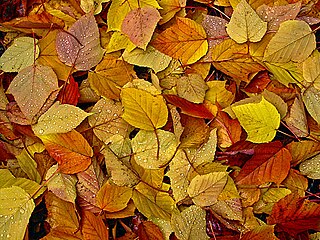
A chromophore is a molecule which absorbs light at a particular wavelength and emits color as a result. Chromophores are commonly referred to as colored molecules for this reason. The word is derived from "chromo-," which means color, and "-phore," which means "carrier of." Many molecules in nature are chromophores, including chlorophyll, the molecule responsible for the green colors of leaves. The color that is seen by our eyes is that of the light not absorbed by the reflecting object within a certain wavelength spectrum of visible light. The chromophore indicates a region in the molecule where the energy difference between two separate molecular orbitals falls within the range of the visible spectrum. Visible light that hits the chromophore can thus be absorbed by exciting an electron from its ground state into an excited state. In biological molecules that serve to capture or detect light energy, the chromophore is the moiety that causes a conformational change in the molecule when hit by light.
Leaf area index (LAI) is a dimensionless quantity that characterizes plant canopies. It is defined as the one-sided green leaf area per unit ground surface area in broadleaf canopies. In conifers, three definitions for LAI have been used:

The normalized difference vegetation index (NDVI) is a widely-used metric for quantifying the health and density of vegetation using sensor data. It is calculated from spectrometric data at two specific bands: red and near-infrared. The spectrometric data is usually sourced from remote sensors, such as satellites.
The photosynthetic efficiency is the fraction of light energy converted into chemical energy during photosynthesis in green plants and algae. Photosynthesis can be described by the simplified chemical reaction
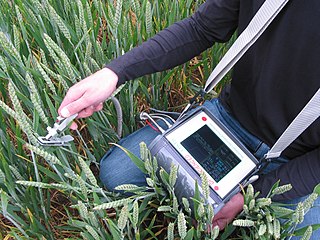
A fluorometer, fluorimeter or fluormeter is a device used to measure parameters of visible spectrum fluorescence: its intensity and wavelength distribution of emission spectrum after excitation by a certain spectrum of light. These parameters are used to identify the presence and the amount of specific molecules in a medium. Modern fluorometers are capable of detecting fluorescent molecule concentrations as low as 1 part per trillion.

Solar geoengineering, or solar radiation modification (SRM), is a type of climate engineering in which sunlight would be reflected back to outer space to limit or offset human-caused climate change. There are multiple potential approaches, with stratospheric aerosol injection (SAI) being the most-studied method, followed by marine cloud brightening (MCB). Other methods have been proposed, including a variety of space-based approaches, but they are generally considered less viable, and are not taken seriously by the Intergovernmental Panel on Climate Change. SRM methods could have a rapid cooling effect on atmospheric temperature, but if the intervention were to suddenly stop for any reason, the cooling would soon stop as well. It is estimated that the cooling impact from SAI would cease 1–3 years after the last aerosol injection, while the impact from marine cloud brightening would disappear in just 10 days. Contrastingly, once any carbon dioxide is added to the atmosphere and not removed, its warming impact does not decrease for a century, and some of it will persist for hundreds to thousands of years. As such, solar geoengineering is not a substitute for reducing greenhouse gas emissions but would act as a temporary measure to limit warming while emissions of greenhouse gases are reduced and carbon dioxide is removed.

Plant stress measurement is the quantification of environmental effects on plant health. When plants are subjected to less than ideal growing conditions, they are considered to be under stress. Stress factors can affect growth, survival and crop yields. Plant stress research looks at the response of plants to limitations and excesses of the main abiotic factors, and of other stress factors that are important in particular situations. Plant stress measurement usually focuses on taking measurements from living plants. It can involve visual assessments of plant vitality, however, more recently the focus has moved to the use of instruments and protocols that reveal the response of particular processes within the plant
Breeding for drought resistance is the process of breeding plants with the goal of reducing the impact of dehydration on plant growth.
Plant breeding is process of development of new cultivars. Plant breeding involves development of varieties for different environmental conditions – some of them are not favorable. Among them, heat stress is one of such factor that reduces the production and quality significantly. So breeding against heat is a very important criterion for breeding for current as well as future environments produced by global climate change.















